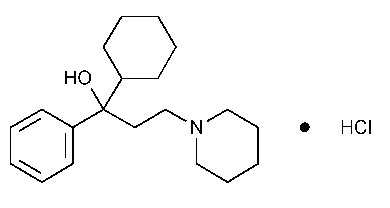Trihexyphenidyl Hydrochloride
1-Piperidinepropanol,a-cyclohexyl-a-phenyl-,hydrochloride,(±)-.
(±)-a-Cyclohexyl-a-phenyl-1-piperidinepropanol hydrochloride [52-49-3].
»Trihexyphenidyl Hydrochloride contains not less than 98.0percent and not more than 102.0percent of C20H31NO·HCl,calculated on the dried basis.
Packaging and storage—
Preserve in tight containers.
Identification—
A:
Infrared Absorption á197Kñ.
B:
It responds to the tests for Chloride á191ñ.
C:
The retention time exhibited by trihexyphenidyl hydrochloride in the chromatogram of the Assay preparationcorresponds to that of the Standard preparation,as obtained in the Assay.
Loss on drying á731ñ—
Dry it at 105 for 3hours:it loses not more than 0.5%of its weight.
for 3hours:it loses not more than 0.5%of its weight.
Residue on ignition á281ñ:
not more than 0.1%.
Heavy metals,Method IIá231ñ:
0.002%.
Chloride content—
Dissolve about 1.2g,accurately weighed,in a mixture consisting of 50mLof methanol,5mLof glacial acetic acid,and 5mLof water.Add 3drops of eosin Y TS,and mix.Stir,preferably with a magnetic stirrer,and titrate with 0.1Nsilver nitrate VSuntil the straw-orange suspension that forms during the titration changes sharply to red.Each mLof 0.1Nsilver nitrate is equivalent to 3.545mg of Cl.Not less than 10.3%and not more than 10.7%of Cl,calculated on the dried basis,is found.
Chromatographic purity—
Standard preparations—
Dissolve USP Trihexyphenidyl Hydrochloride RSin a mixture of chloroform and isopropylamine (98:2),and mix to obtain a solution having a known concentration of 2.5mg per mL.Dilute quantitatively with a mixture of chloroform and isopropylamine (98:2)to obtain Standard preparation A,containing 500µg of the Reference Standard per mL,and Standard preparation B,containing 250µg of the Reference Standard per mL.
Test preparation—
Dissolve an accurately weighed quantity of Trihexyphenidyl Hydrochloride in a mixture of chloroform and isopropylamine (98:2)to obtain a solution containing 50mg per mL.
Spray reagent—
Dissolve 0.8g of bismuth subnitrate in a mixture of 40mLof water and 10mLof glacial acetic acid (Solution A).Dissolve 8g of potassium iodide in 20mLof water (Solution B).On the day of use,mix equal volumes of Solution Aand Solution B.
Procedure—
Apply separately 10µLof the Test preparationand 10µLof each Standard preparationto a suitable thin-layer chromatographic plate (see Chromatography á621ñ)coated with a 0.25-mm layer of chromatographic silica gel mixture.Position the plate in a chromatographic chamber,and develop the chromatograms in a solvent system consisting of a mixture of hexane and isopropylamine (98:2)until the solvent front has moved about three-fourths of the length of the plate.Remove the plate from the developing chamber,mark the solvent front,allow the solvent to evaporate,and spray the plate,first with the Spray reagent,and then with sodium nitrite solution (4in 100).Compare the intensities of any secondary spots observed in the chromatogram of the Test preparationwith those of the principal spots in the chromatograms of the Standard preparations.No secondary spot from the chromatogram of the Test preparationis larger or more intense than the principal spot obtained from Standard preparation B(0.5%),and the sum of the intensities of all secondary spots obtained from the Test preparationcorresponds to not more than 1.0%.
Organic volatile impurities,Method IVá467ñ:
meets the requirements.
Assay—
Mobile phase—
Prepare a mixture of acetonitrile,water,and triethylamine (920:80:0.2),adjust with phosphoric acid to a pHof 4.0,mix,filter,and degas.Make adjustments if necessary (see System Suitabilityunder Chromatography á621ñ).
Standard preparation—
Dissolve an accurately weighed quantity of USP Trihexyphenidyl Hydrochloride RSin acetonitrile,and dilute quantitatively,and stepwise if necessary,with acetonitrile to obtain a solution having a known concentration of about 0.2mg per mL.
Assay preparation—
Transfer about 20mg of Trihexyphenidyl Hydrochloride,accurately weighed,to a 100-mLvolumetric flask,dissolve in acetonitrile,dilute with acetonitrile to volume,and mix.
Chromatographic system
(see Chromatography á621ñ)—The liquid chromatograph is equipped with a 210-nm detector and a 4.6-mm ×8-cm column that contains 3-µm packing L1.The flow rate is about 2mLper minute.Chromatograph the Standard preparation,and record the peak responses as directed for Procedure:the column efficiency determined from the analyte peak is not less than 1300theoretical plates,the tailing factor for the analyte peak is not more than 3.0,and the relative standard deviation for replicate injections is not more than 1.0%.
Procedure—
Separately inject equal volumes (about 10µL)of the Standard preparationand the Assay preparationinto the chromatograph,record the chromatograms,and measure the responses for the major peaks.Calculate the quantity,in mg,of C20H31NO·HCl in the portion of Trihexyphenidyl Hydrochloride taken by the formula:
100C(rU/rS),
in which Cis the concentration,in mg per mL,of USP Trihexyphenidyl Hydrochloride RSin the Standard preparation,and rUand rSare the trihexyphenidyl peak responses obtained from the Assay preparationand the Standard preparation,respectively.
Auxiliary Information—
Staff Liaison:Ravi Ravichandran,Ph.D.,Senior Scientist
Expert Committee:(PA3)Pharmaceutical Analysis 3
USP28–NF23Page 1980
Phone Number:1-301-816-8330
